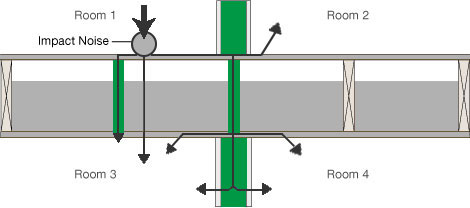You can insulate our roof, and you can insulate our walls, but can you insulate between two floors within a house to reduce noise?
Putting insulation between the ground and first floor should, in theory, stop sound, vibration and heat from moving between levels in your property. This will also increase thermal insulation for the room above and below, making them more comfortable to be in and quieter too.
By using acoustic floor insulation, you block air cavities between floors that enable ambient sound to travel. You also reduce the space in which joists and floorboards can vibrate which reduces vibration noise. Utilised in conjunction with the proper pointing tape or gripper strip, this kind of insulation can be a very cost-effective way to insulate your home against noise.
Sound travels in two ways, through the air and physically through impact. Airborne, or ambient noise, would be the noise of a TV or music in an upstairs room or people talking. Examples of impact sounds would include the thump of something hitting the floor or the sound of feet or heels walking around upstairs.
Effective acoustic insulation needs to be able to handle both types of sound. If you have laminate or wood flooring in the upper levels of your home and you have noisy teens or just want to be able to have a private conversation, acoustic floor insulation is for you!
In the image below you can see that as something hits the floor in Room 1, it transfers along the floor into Room 2 and through beams and joists into Room 3 and Room 4 as well. Acoustic insulation would absorb that sound at the point of contact and reduce the spread of, or prevent entirely, noise from travelling.

Acoustically insulating the ground floor
Insulating the ground floor is the best way to stop impact noise from vibrating across the floor of the house. Loud footsteps in the kitchen can translate to reverberations in the living room if they’re on the same floor. Insulating a ground floor also allows you to save heat. If your floor is not already insulated, you could be losing around 10% of your heat into the ground from under your feet.
If your home has a suspended floor (meaning there’s a gap between the floorboards and the concrete/ground underneath), you will benefit from thermal as well as acoustic insulation. If you have a solid concrete floor with a layer of flooring directly above it, acoustic insulation won’t make much of an impact but thermal insulation will.
Use Insulating a Floor guide for both suspended and solid floors.
Acoustically insulating between floors
Insulating between the floors in your home offers both heat and sound insulation benefits. It is also relatively simple to do with the right tools. The good news is that products such as JCW Impactalay Plus Acoustic Floor Insulation are designed to provide sound insulation that delivers that valuable peace and quiet we all strive for. With three acoustic layers to combat both impact and ambient sound, this product and others like it have been designed specifically for insulating between floors in your home.
Acoustic insulation is relatively easy to install, very effective and great value for money. It also makes your life quieter and more peaceful!













